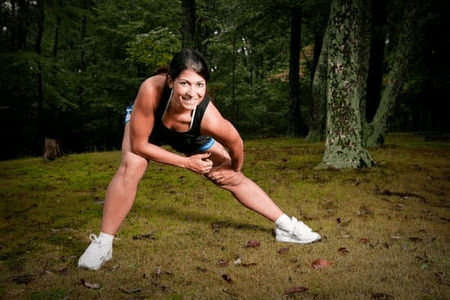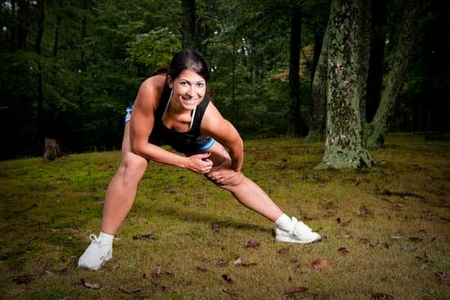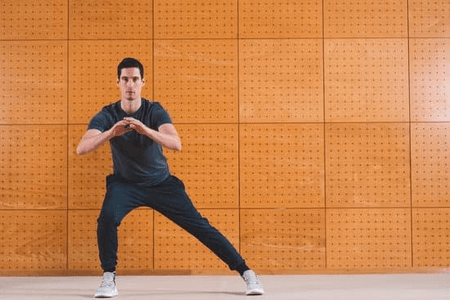Many runners lace up their shoes and hit the pavement with intensity, but they often overlook a crucial component of their training routine: stretching. As an experienced running coach with years of guiding athletes to peak performance, I've witnessed first-hand how incorporating strategic flexibility exercises can make all the difference.
Stretching isn't just about bending and reaching – it's a powerful tool that can boost your endurance, enhance muscle coordination, and keep you on track by preventing time-out due to injuries.
Despite its benefits, many in the running community cling to outdated beliefs about stretching. Dynamic warm-ups offer much more than mere muscle preparation; they activate your mind-muscle connection for an optimal run.
Say goodbye to myths like 'stretching weakens muscles' or 'it doesn’t prevent harm.' Research dispels these misconceptions by highlighting dynamic stretches as key in maintaining a muscle-tendon unit primed for action without compromising power or performance.
Ready to stride into top gear? Keep reading – your best run starts here.

Key Takeaways
- Dynamic stretches like walking lunges and leg swings improve muscle power and flexibility, making them important before a run to prevent injuries.
- Static stretches should be done after running to help muscles relax while dynamic stretching can be part of the warm-up routine.
- Mixing both dynamic and static stretching with strength training helps manage pain and lowers the chance of getting hurt.
- Regular dynamic stretching before running makes muscles ready for exercise without hurting muscle strength or performance.
- Adding exercises like heel-to-bum kicks to your routine activates key lower body muscles, helping you run better and avoid injuries.
The Importance of Stretching for Runners

Dynamic stretching is considered more beneficial for runners as it helps increase muscle power output, range of motion, and overall athletic performance. It also plays a significant role in preventing injuries and managing pain during runs.
Static vs. Dynamic Stretching
When it comes to running, understanding the differences between static and dynamic stretching is crucial for your routine. Here's a breakdown in table format:
Static Stretching |
Dynamic Stretching |
|---|---|
| Holding a stretch for a period of time, usually 15-60 seconds. | Stretching through movement, typically involving active muscle contractions. |
| Best performed after running to help with flexibility. | Ideal before a run to prepare muscles for movement. |
| May reduce muscle power if not followed by dynamic exercises. | Shown to improve performance in activities like running. |
| Not associated with a decrease in running injuries. | Can improve muscle performance and is not linked to performance deficits. |
| Can have a detrimental effect on muscles if done immediately before exercise. | Helps with muscle warm-up and is recommended before exercise. |
| Often considered a myth that it improves running performance or decreases injury risk. | Supports the idea that specific stretching type and timing are important for benefits. |
| May not be enough to prevent injuries on its own; should be combined with other strategies. | Encourages blood flow and primes the body, reducing injury risk when combined with other strategies. |
Remember, while both types of stretching have their place in a runner's regimen, they serve different purposes and should be used accordingly.
Benefits of Dynamic Stretching Before a Run

Dynamic stretching before a run helps in warming up the muscles and increase flexibility, which can enhance performance and reduce the risk of injuries. It activates the muscles and improves blood flow, preparing the body for the upcoming physical activity.
Dynamic stretching also helps to improve muscle power output without negatively impacting strength or performance. Incorporating dynamic stretching into your pre-run routine can improve running experience and lower chances of muscle strains or sprains.
By adding dynamic stretches like leg swings, walking lunges, or heel-to-bum kicks before hitting the pavement, runners can optimize their performance while minimizing injury risks.
Stretching for Pain Management and Injury Prevention

Stretching can help manage pain and prevent injuries for runners. It may not entirely prevent soreness, but it improves flexibility and muscle strength essential for preventing running injuries.
While static stretching alone doesn't seem to decrease the risk of injury, combining it with other preventive measures like strength training can be beneficial. Also, dynamic stretching before a run has been found to improve performance without harming muscle strength or power output.
Therefore, incorporating a combination of dynamic and static stretches as part of your warmup routine before a run can contribute to better overall performance and lower the risk of injuries.
Dynamic Stretching Techniques for Runners
Incorporating dynamic stretching techniques into your running routine can help improve your flexibility and range of motion. These include exercises like walking lunges, side lunges, leg swings, walking single-leg deadlifts, and heel-to-bum kicks.
Walking Lunges

Walking lunges are a great dynamic stretching exercise for runners. It helps to warm up your muscles and increase flexibility, which is crucial for preventing injuries. By incorporating walking lunges into your pre-run routine, you can improve your overall performance and reduce the risk of muscle strains during your run.
This dynamic stretching technique targets multiple muscle groups, including the quadriceps, hamstrings, glutes, and calves. It also promotes better range of motion in the hip flexors, which is essential for efficient running mechanics.
So before you hit the pavement or trail for a run, consider adding walking lunges to your warm-up routine to enhance your performance and protect against potential injuries.

Side Lunges
Side lunges are a great dynamic stretching technique for runners. They work the inner and outer thighs, hips, and groin muscles, promoting flexibility and range of motion. Side lunges also engage the quadriceps, hamstrings, and glutes, which are crucial for running power and stability.
Additionally, these lunges help improve balance and coordination, reducing the risk of injury while running.
When done properly before a run or workout session, side lunges can warm up the lower body muscles while improving hip mobility, which is essential for proper running form.
Leg Swings
After incorporating side lunges into your dynamic stretching routine, leg swings are another effective technique for runners. Leg swings help to improve hip flexibility and range of motion, which is crucial for maintaining proper running form and preventing injuries.
These exercises also activate the muscles in the legs, helping to prepare them for the demands of running. By engaging in leg swings before a run, you can promote better performance and reduce the risk of muscle strains during your workout.
Incorporating these dynamic stretches into your pre-run routine can make a significant difference in your overall running experience.
Walking single-leg Deadlifts
Walking single-leg deadlifts are an effective dynamic stretching technique for runners. They help improve balance, stability, and flexibility in the hamstrings and lower back. This exercise also engages the core muscles, promoting better posture and reducing the risk of injuries during running.
Studies have shown that dynamic stretching like walking single-leg deadlifts can enhance performance without impacting muscle power output negatively.
Runners must incorporate walking single-leg deadlifts into their warm-up routine before a run. By performing this dynamic stretch, runners can activate multiple muscle groups and prepare their bodies for the demands of running, ultimately boosting their overall performance while reducing the likelihood of injury.
Heel-to-bum Kicks
Heel-to-bum kicks, also known as butt kicks, are a dynamic stretching technique that can help runners improve their performance and prevent injuries. This exercise involves bringing your heels up towards your glutes while jogging in place.
By doing this, you stretch the quadriceps muscles at the front of your thighs and improve flexibility in the hip flexors. Incorporating heel-to-bum kicks into your warm-up routine before a run can help increase muscle elasticity and prepare your body for the activity ahead.
Additionally, dynamic stretching like heel-to-bum kicks has been shown to improve running performance without compromising strength or power output. It's an effective way to activate and loosen up key lower body muscles essential for running, helping to reduce the risk of injury during your workout.
The Best Time to Stretch for Runners
Dynamic stretching before a run can help prepare the muscles for activity and improve range of motion. After a run, static stretching can help reduce muscle tension and aid in recovery.
Before a Run
Dynamic stretching is crucial for runners before a run. It helps warm up the muscles, increase flexibility, and improve performance while reducing the risk of injury. Dynamic stretches like walking lunges, leg swings, and heel-to-bum kicks activate the muscles and prepare them for the demands of running.
Research has shown that dynamic stretching before a run can enhance athletic performance without compromising muscle power output or strength. Incorporating dynamic stretching into your pre-run routine can be beneficial in boosting your running performance and preventing injuries.
After a Run
After a run, dynamic stretching can help cool down and improve flexibility. Walking lunges, side lunges, leg swings, walking single-leg deadlifts, and heel-to-bum kicks are effective techniques to incorporate after running.
Dynamic stretching at this time aids in preventing muscle tightness and injury while also enhancing overall performance. Runners need to engage in proper post-run stretching routines as it can contribute significantly to their flexibility training and sports performance.
Conclusion
To summarize, dynamic stretching before running benefits performance and injury prevention. The techniques provided are practical, easy to implement, and efficient. How will you incorporate these stretching methods into your running routine? Consider making stretching a vital part of your training plan.
Training with dynamic stretches can lead to significant improvements in your running performance and reduce the risk of injuries. Keep exploring more on how you can optimize your running experience through effective stretching techniques.
FAQs
1. Why is stretching important for runners?
Stretching helps runners boost their performance and prevent injuries by making muscles more flexible.
2. Can stretching make me a better runner?
Yes, regular stretching can improve your running by helping your muscles work better.
3. When should I stretch if I like to run?
It's best to stretch both before and after you go for a run to keep your muscles safe and help them recover.
4. What happens if I don't stretch when I run?
If you skip stretching, you might hurt yourself or not perform as well because your muscles are not prepared or recovered.
Before adhering to any of the information or recommendations or undertaking any exercise program or diet regimen, you should consult your physician.
DISCLAIMER
This document is provided for general information purposes only and should not be relied upon as providing legal advice, technical, or specific operational guidance to the reader, whether as to the practices described in the document or the applicable legal requirements and regulations. SAVE ON SNEAKS expressly disclaims any responsibility for liability arising from or related to the use or misuse of any information in this document.



